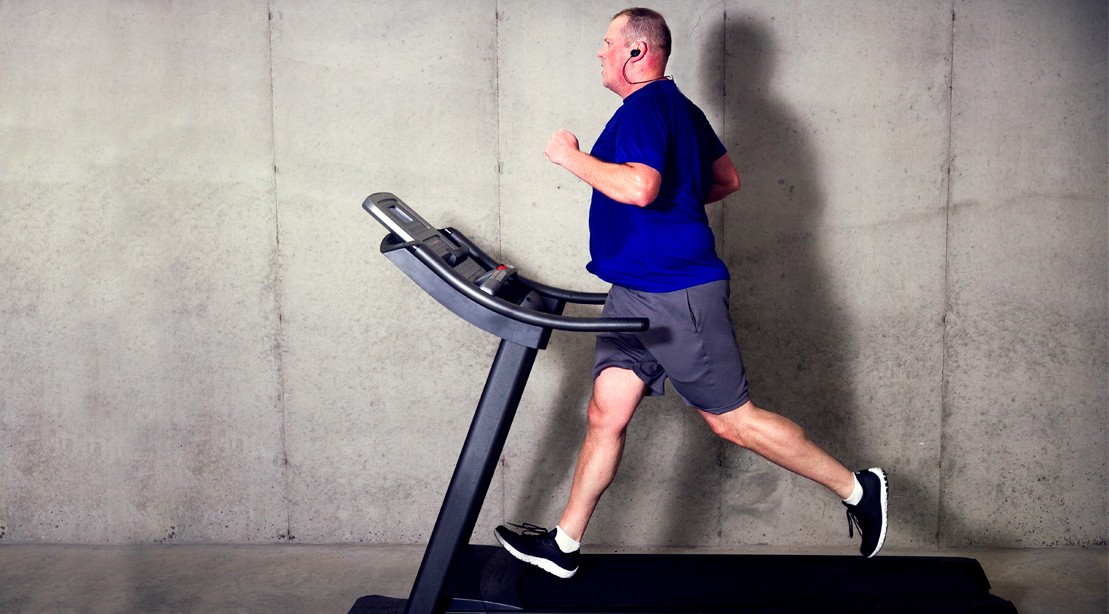The Right Type of Exercise Can Help Control Diabetes

One of the most common pieces of advice for people with diabetes is to exercise, since it can help lower blood sugar levels and reduce weight. Plus, there are plenty of other benefits to exercise that improve overall wellness and may have a tangential connection to diabetes, potentially easing symptoms—effects like better sleep, improved immune response, more energy, less sugar cravings, and lower stress.
But just throwing out the advice to "get some movement" or to join a gym isn't appropriate in the way it would be for those without the condition. In fact, it could even put them at risk.
"Both types of diabetes, Type 1 and Type 2, benefit from exercise, especially if weight is an issue, but they have to be careful in terms of when and how that exercise happens," says Joshua Scott, M.D., primary care sports medicine physician at Cedars-Sinai Kerlan-Jobe Institute in Los Angeles. "That's especially true when you put medication into the equation."
For example, he says, many diabetes medications lower blood sugar levels. But exercise also provides that effect, which means those with diabetes could experience hypoglycemia—also called low blood sugar, when the body begins running out of glucose as energy—both during and after exercise.
"That hypoglycemia can possibly be late onset, which means it could begin up to 24 hours after exercise," says Scott. "That means they could bottom out by doing this thing that's supposed to be so good for them."
That's why being prepared with a proper plan, the right resources, and smart strategies around nutrition and snacks is crucial.
[RELATED1]
Find Appropriate Resources
There are thousands of online fitness classes and countless in-person options, not to mention personal trainers and wellness coaches. But as Scott noted, simply choosing one isn't enough. In fact, exercising without diabetes-friendly advice could be highly detrimental.
That's the impetus behind a recently developed digital app, GlucoseZone, that tailors workout advice for those with Type 1, Type 2, and prediabetes. The app provides guidance based on real-time blood glucose levels, as well as other variables like medication, fitness level, body weight, exercise preferences. It can also be integrated with wearable devices like insulin pumps, according to Charles O'Connell, GlucoseZone founder and CEO.
“I've met many people with diabetes who want to exercise, but they don't know what to do," he says. "They're not lazy, quite the opposite. But they have unique requirements and they're right to be cautious about workouts."
The app has been in development for nearly four years, with clinical pilot programs that have led to refining the way the app works, he adds. By providing exercise programs that take not just fitness level into account but also real-time blood sugar monitoring and medication usage, GlucoseZone can be an important part of treatment, O'Connell believes.
"Every medication for Type 2 diabetes is indicated for use as an adjunct to nutrition and exercise," he says. "That means if you're not exercising, the medications don't work the way they should. Also, there's a difference between Type 1 and Type 2, and the exercise guidance should be different, too. We believe this helps to fill a gap in the standard of care."
Even if you're completely new to exercising, the app can help you get started, according to diabetes fitness trainer Justin Emmans, who develops content for GlucoseZone, including its beginner program, Couch to 7.0 (the A1c level considered an ideal target for people with diabetes).
As a Type-1 diabetic himself, Emmans began exercising as a way to control his diabetes, but struggled to keep his blood sugar at just the right level to prevent hypoglycemia while working out. He got involved with GlucoseZone as a way to help others facing the same challenges.
"Exercise is tough for people with diabetes because they're always trying to navigate what's effective and safe," he says. "This takes the guesswork out, so people can enjoy their workouts."
Fuel Up Before and After Correctly
In addition to using GlucoseZone, a huge part of diabetes control is understanding pre-workout and post-workout nutrition options as well.
"A pre-workout snack or meal containing carbs is much more likely to provide the quick energy your body needs to have an effective workout than a supplement," says dietician McKenzie Caldwell, R.D.,N., owner of Feed Your Zest Nutrition & Wellness, who has diabetes nutrition as one of her specialties. "Depending on intensity, length, and timing of your workout, as well as medication or insulin, how you eat to fuel a workout may differ slightly from your overall eating pattern to manage diabetes."
For example, she says, the protein, fiber, and fat that keep blood glucose from spiking after a balanced meal with carbs may work for those who aren't on insulin or who are doing a low-intensity workout. However, someone who is on medication and up for a HIIT workout may need to eat more simple carbs before exercise to keep blood sugar from getting too low.
In terms of post-workout options, Caldwell recommends the "rule of 15," which means 15 grams of carbs within 15 minutes after you end an exercise session. Combine it with protein, she adds, and you'll get muscle-building benefits as well.
But if you test your glucose after working out and it's below 100 mg/dL, you could be at risk for low blood sugar, she says. In that case, ditch the protein and go for simple carbs like half a cup of juice or a tablespoon of honey. Wait 15 minutes, and test again. Repeat until your blood sugar level rises above 100 mg/dL, and add the protein into your next meal.
[RELATED2]
Download the Glucosezone app for workouts
from Muscle & Fitness https://ift.tt/2SaUprX
Comments
Post a Comment